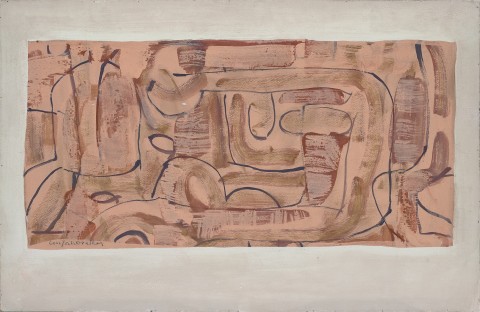COMPOSITION, c.1960 – 61
IAN FAIRWEATHER
synthetic polymer paint and gouache on paper on composition board
65.5 x 101.0 cm
signed lower left: Ian Fairweather
bears inscription verso: COMPOSITION BY IAN FAIRWEATHER / 95 GNS – FOR RAYMOND BURR
Macquarie Galleries, Sydney
Raymond Burr, USA, acquired from the above, c. 1962
Macquarie Galleries, Sydney
John Lane, acquired from the above in 1963
Sir Tristan Antico, Sydney
Sotheby's, Melbourne, 19 April 1994, lot 82, (as 'Composition 200')
Niagara Galleries, Melbourne
Private collection
Philip Bacon Galleries, Brisbane (label attached verso)
Niagara Galleries, Melbourne
Private collection, Sydney, acquired from the above in 1998
Ian Fairweather and Emily Kngwarreye, Niagara Galleries, Melbourne, 31 January – 18 February 1995, cat. 4 (illus., in exhibition catalogue, as ‘Painting 6 (?)’)
Roberts, C., Ian Fairweather and China, The Miegunyah Press, Melbourne, 2021, pp. 155 - 156 (illus., as ‘Painting VI’)
Being interviewed in 1965, Ian Fairweather described painting as ‘something of a tightrope act’, saying it was ’difficult to keep one’s balance.’ He went on to explain that for him, painting sat ‘between representation and the other thing – whatever it is.’1 The ‘other thing’ was abstraction and it was in the late 1950s that he made his first concentrated foray into purely non-representational art. In 1959, by which time he had settled on Bribie Island, Fairweather sent twenty works to his dealers in Sydney, writing ‘they are mostly done on newspaper – (as I ran out of other paper) … They are also (mostly) without titles – for they really refer (mostly) to nothing in particular – sort of soliloquies – I suppose will have to come under the heading of abstracts – Signed in pencil at bottom to indicate what side is up’.2
Another batch was received the following April, and in July that year a selection was exhibited at Macquarie Galleries. While the critical reception was muted – as it often is when an artist changes direction and critics scramble to catch up – there were positive sales. Among others, Mervyn Horton, the editor of Art and Australia, bought one of the large works and reproduced Painting X, 1960 (private collection, London) on the cover of the inaugural issue of the journal in 1963. The Art Gallery of South Australia purchased another from an Adelaide Festival exhibition the following month.3 Other abstracts from this time have since been acquired by major collecting institutions including Queensland Art Gallery/Gallery of Modern Art and the National Gallery of Australia.
Like Composition, c.1960-61, many of these paintings incorporate a painted border which frames the central image on four sides as in this example – or suspends it between horizontal bands above and below – introducing space into otherwise complex compositions. In this work, a silvery-grey border surrounds a series of black painted lines and broad brown and tan brush strokes which intermingle with the paler, fleshy-coloured ground. Without a recognisable subject commanding our attention, it is the rhythmic action of Fairweather’s painting, the confidence of his gesture and line, as well as the delicate layering, which prevails. These works emphasise the act of painting, rather than the end result. Murray Bail sums it up well, writing ‘Fairweather …has consciously used abstraction to speak of experience beyond the experience of art itself… He is articulating mood.’4
Although Fairweather’s focus on abstract or ‘unrealistic’ art, as he preferred to term it,5 was relatively short-lived, these works are especially significant as precursors to the great large-scale masterpieces of his career, almost abstract paintings such as Monastery, 1960 (National Gallery of Australia) and Monsoon, 1961-62 (Art Gallery of Western Australia) which, over time, have come to symbolise his brilliant and singular contribution to Australian art.
1. The artist quoted in Bail, M., et. al., Fairweather, Art & Australia Books in association with Queensland Art Gallery, Brisbane, 1994, p. 139
2. Fairweather to Treania Smith, 11 November 1939, cited in Roberts, C. & Thompson, J. (eds.), Ian Fairweather: A Life in Letters, Text Publishing, Melbourne, 2019, p. 243
3. See Bail, M., Ian Fairweather, Murdoch Books, Sydney, revised edition 2009, p. 161
4. Ibid.
5. Ibid. p. 165
KIRSTY GRANT
